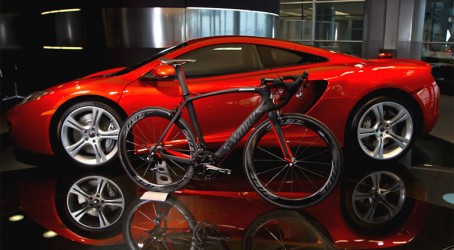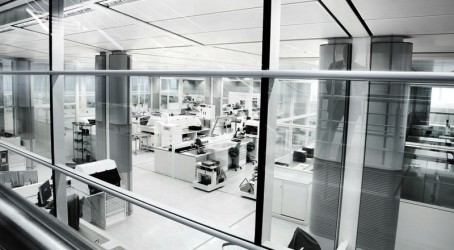Housed deep inside McLaren’s futuristic-looking headquarters in Woking, Surrey is a small team of engineers who are successfully applying design and manufacturing skills first honed in motorsport into a host of other areas.
The work of the McLaren Applied Technologies division first came to prominence a couple of years ago on a project with Specialized that developed a phenomenally lightweight carbon-fibre bike used by sprinter Mark Cavendish to power to green jersey glory in the Tour de France. Since then the engineers at McLaren’s Skunk Works have quietly brought their knowledge to bear on a range of other sporting equipment including tennis rackets and golf clubs.
And now they are turning their attention to predictive analytics, applying in-depth knowledge of telemetry systems to enable sports organisations to foretell athlete performance more accurately.
The diverse nature of these activities means the message is starting to resonate: McLaren doesn’t just make very fast cars – it is quickly becoming a technology leader in many other areas. This has been a well-considered transformation, says Geoff McGrath, managing director of McLaren Applied Technologies, and it is one that will continue into the future.
“It was never about taking racing technology and simply applying it outside of the traditional business,” he says. “What we offer is a very different way of thinking and a very different way of designing that can work in many other industries.
“The remit was to establish McLaren Applied Technologies as a business and to make it grow. When I joined three years ago there were two people. We now employ 40 staff, most of them engineers. The business has also been profitable for the last two years. I’m very proud of that. It’s a good start-up story.”
The success of McLaren as a Formula One team and as a maker of high-end supercars means that it has developed a rich pedigree in design and engineering, aerodynamics and lightweight structures. Those were the attributes that bicycle components firm Specialized wanted to tap into with the development of the S-Works McLaren Venge road bike. But, as McGrath explains, first it was necessary to take a step back to redefine customer requirements.
“Specialized came to us saying ‘we want a bike that is lighter and faster’. But we thought we could challenge the way they design bikes and optimise the product to the rider. We said let’s take a look at how the bike works – we instrumented it, we measured how it worked on different terrain, then we measured how it behaved with different riders. We built vehicle dynamics models, and those models became the design tool. For professional engineers this is the way you design stuff – but not necessarily for a cycle company. That was not how they thought.”
The approach worked wonders. Specialized and McLaren’s engineers collaborated to come up with the Venge, which featured several novel innovations in terms of weight, stiffness and aerodynamics. At about 1kg the Venge was already remarkably light but the use of McLaren expertise in finite element analysis and custom software normally employed in F1 development meant that it was possible to cut the weight by another 15%.


The bike’s chainstays, bottom brackets and seat tube were constructed as one piece, with continuous fibre alignment and internal ribbing in critical areas. This design maximised stiffness to resist deflection under extreme pedal loads, improving power transfer.
A strategically designed head tube/steerer assembly tapered from 1 1/8in to 1 3/8in at the crown for maximum torsional stiffness and curved in at the waist for a narrow profile to minimise drag. Another innovation saw an integrated toe cap that curved into a bevel in the top tube for seamless interface, turning with the steer tube for smoother air flow. Cambered airfoil X-section seat stays featured a flat outer surface and smooth, rounded inner surface to calm crosswind airflow as it passed by the wheel.
The X-section for the wheel blades presented a narrow edge to the wind, and ran in a straight line from crown to dropouts, optimising lateral stiffness and handling.
More recently, engineers from McLaren Applied Technologies have been working with other unnamed sports firms on products such as tennis rackets and golf equipment using a design philosophy that starts with advanced telemetry and sensor technologies to capture highly accurate measurement data. “We find that this design philosophy works very well across a range of sporting equipment,” says McGrath.
The team has also been approached by a yacht maker who wants to use McLaren’s skills to optimise weight. “Yes, we can help shape the structure to make a yacht faster, and we can help make it lighter,” says McGrath. “But we can also instrument it, using modelling to anticipate when the mast is being loaded excessively, or tacked too hard. That sets us apart. Most of the competition are selling components. We sell a certain approach.”
The success of this approach means that the Applied Technologies division is growing fast, but McGrath doesn’t want it to get much bigger for fear of cultural factions emerging among employees in specific disciplines. The answer, he says, is to stay small but to partner very carefully with bigger companies.
“A good partner would be a market leader who would work with four or five of our staff on some novel product that they are developing. If not the market leader, it might be a subversive new entrant that is going to disrupt the market. Following that approach, I think we can do great things without losing our distinct culture,” he says.
That sort of business model shapes the types of engineers that McLaren Applied Technologies requires. McGrath says that the sort of people he likes to recruit have what he describes as a “T profile” – they have deep expertise in some area but are also lateral thinkers. “I don’t necessarily want someone who is pure motorsport. It takes a certain type of person to work here – someone who really thrives on what is often the hardest phase of any new job: the definition of the problem. If a good creative engineer gets that right, then the execution tends to follow naturally,” he says.
And in what other areas might the company emerge as a technology developer? “We are already active in oil and gas, where our telemetry skills have relevance for remote condition monitoring,” he says. There is also potential in defence. McGrath says it does not take a great leap of imagination to understand how remote condition monitoring technologies might prove valuable in troop positioning.
Intriguingly, McGrath says that engineers will also be working with national sports organisations in the run-up to the 2016 Olympic Games, applying systems that can help to predict athlete performance. “Predictive analytics is a very interesting area,” he says. “Simulation and the capturing of accurate measurements can be turned into intelligent insight. That really is a sweet spot for us.”